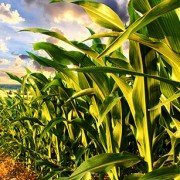Nitrogen stabilizers
Nitrogen management has always been a challenge in high nitrogen demand crops such as corn and winter wheat.
The three pathways that can contribute to significant nitrogen loss are:
- Volatilization (loss of ammonia nitrogen to the atmosphere from the soil surface),
- Denitrification (which occurs when soils are saturated and in an anaerobic environment) and
- Leaching (downward movement of nitrate nitrogen out of the rooting zone due to excessive rains)
The challenge has always been to make nitrogen available when the crop needs it and minimize the exposure of nitrogen to the weather scenarios that contribute to N loss. Consider the nitrogen response relationship for corn and winter wheat (below):
Corn nitrogen response curve
(Adapted from Richie, et.al, 2005, How a Corn Plant Develops).

We often apply nitrogen early in the season before the crop actually utilizes it. For example, the demand for nitrogen in corn is at its peak at about the V10 growth stage (often around early to mid-July). Split-applying nitrogen has been a reasonably effective way to reduce the risk of nitrogen loss, however, with added application costs. Read more



 Late season nitrogen application has been a hot topic amongst farmers and uptake in this practice has increased in recent years. The expense and environmental impact has made growers think differently about nitrogen application.
Late season nitrogen application has been a hot topic amongst farmers and uptake in this practice has increased in recent years. The expense and environmental impact has made growers think differently about nitrogen application.